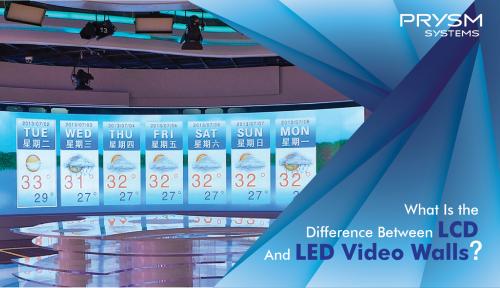What Is the Difference Between LCD And LED Video Walls?

Finally, decided to incorporate video wall technology? Well, you took the right decision now, the next step of the process is to decide which technology you want to associate according to your needs. Is it going to be LED or LCD video walls?
“When you cruise along with the world, and then technology changes. You have to adapt.”
Gone are the days when large wall displays were reserved for only big brands, stadiums, and malls who could spare the budget to afford them. As the technology changed, Video walls became accessible and affordable for businesses who always wished to use them in corporate events and operation centers. Now, the only tough choice they have to make is to choose between LED and lcd video walls.
Those who are waiting for an opportunity to jump into the world of video wall displays may face the biggest question that is whether they want LCD or LED video wall displays. Taking this decision is not easy as one has to assess several factors deciding which technology is more suitable to meet organizational needs. Here, we have rounded up key considerations that can help you to make the right decision with confidence.
What to look for while choosing between LCD and LED video walls?
Selecting the right video walls for corporate events or operation centers can involve several factors to ensure successful integration. One of the easiest ways to do it is by breaking the difference between two leading video wall technologies- LED and LCD. Here is how you can do it:
Picture quality is what matter
The quality of the picture one is putting on the display is one of the key considerations you need to take in when debating between LCD and LED video walls. If we pay close attention to the reviews of the previous customers- LED video walls to have better picture quality including from black levels to contrasts and color accuracy. While LCD also offers the almost same level of quality, LCD video walls have the upper hand at this point.
What is the underlying technology?
Both Technologies LED and LCD are in the phase of growth where they will adapt to the change with time and demand. Currently both LCD and led video walls to use the Liquid Crystal Display technology and a series of lamps at the backend to produce the image we see on the screen. What sets these two technologies apart is that lamps at the back of LCD video walls are fluorescent, while LED video walls use emitting diodes.
Currently, there are two LED backlight technologies- edge lighting and full array lighting, and as the name suggests lightning is placed at the edge of the panels in edge technology and in the array of the panel at the back screen in panel technology. However, the majority of LED screens come with edge technology hence, offering up-to-date technology.
Size of video walls
If you are looking for technology that is thinner then, go with the LED screens as they are built on emitting diodes that are far smaller than fluorescent, and hence, they result in thinner displays. Second, LED uses the edge technology; they are obviously thinner and the slimmest display solutions available in the market.
Cost- what your budget allows?
If cost is your main concern, then it is highly recommended to go with the conference technologies as it is clear that the LCD technology allows you to buy bigger displays for vast purposes on a less budget. In the end, after considering all of these factors you will be able to choose the right video display solutions to fulfill your corporate needs. Moreover, if you are still facing any issues, then consult with professionals available at Prysm Systems. For more information visit the website.
Post Your Ad Here
Comments